Stack Switching During OS Setup linux 0.11
Stack switching might be a frustrating problem during OS setup.In linux 0.11,
It is easy to find that there are more than one stack defined during the time of OS setup.
Here is a simple experiment, which indicates that the stacks are defined for different purposes.
1. Stack Definition
1.1. The Definition of user_stack
The user_stack appears at line 23 in boot/head.s as follow:
.text
.globl _idt,_gdt,_pg_dir,_tmp_floppy_area
_pg_dir:
startup_32:
...
lss _stack_start,%esp
call setup_idt
...
The definition of stack_start can be found at line 69 in kernel/sched.c as follow:
long user_stack [ PAGE_SIZE>>2 ] ;
struct {
long * a;
short b;
} stack_start = { & user_stack [PAGE_SIZE>>2] , 0x10 };
It is not difficult to understand the struct stack_start:
long* aindicatesESP.short bindicatesSS.
1.2. The definition of Privilege 0 stack
The definition of Privilege 0 stack can be found at line 53 in kernel/sched.c as follow:
union task_union {
struct task_struct task;
char stack[PAGE_SIZE];
};
static union task_union init_task = {INIT_TASK,};
The macro INIT_TASK can be found at line 113 in include/linux/sched.h as follow:
/*
* INIT_TASK is used to set up the first task table, touch at
* your own risk!. Base=0, limit=0x9ffff (=640kB)
*/
#define INIT_TASK \
/* state etc */ { 0,15,15, \
/* signals */ 0,{ {},},0, \
/* ec,brk... */ 0,0,0,0,0,0, \
/* pid etc.. */ 0,-1,0,0,0, \
/* uid etc */ 0,0,0,0,0,0, \
/* alarm */ 0,0,0,0,0,0, \
/* math */ 0, \
/* fs info */ -1,0022,NULL,NULL,NULL,0, \
/* filp */ {NULL,}, \
{ \
{0,0}, \
/* ldt */ {0x9f,0xc0fa00}, \
{0x9f,0xc0f200}, \
}, \
/*tss*/ {0,PAGE_SIZE+(long)&init_task,0x10,0,0,0,0,(long)&pg_dir,\
0,0,0,0,0,0,0,0, \
0,0,0x17,0x17,0x17,0x17,0x17,0x17, \
_LDT(0),0x80000000, \
{} \
}, \
}
The tss_struct is defined at line 51 in include/linux/sched.h as follow:
struct tss_struct {
long back_link; /* 16 high bits zero */
long esp0;
long ss0; /* 16 high bits zero */
long esp1;
long ss1; /* 16 high bits zero */
long esp2;
long ss2; /* 16 high bits zero */
long cr3;
long eip;
long eflags;
long eax,ecx,edx,ebx;
long esp;
long ebp;
long esi;
long edi;
long es; /* 16 high bits zero */
long cs; /* 16 high bits zero */
long ss; /* 16 high bits zero */
long ds; /* 16 high bits zero */
long fs; /* 16 high bits zero */
long gs; /* 16 high bits zero */
long ldt; /* 16 high bits zero */
long trace_bitmap; /* bits: trace 0, bitmap 16-31 */
struct i387_struct i387;
};
It is not difficult to figure out the initializers of esp0 and ss0, which describe the Privilege 0 stack.
2. Simple Experiment
System Info:
Linux ictlxb-Zhaoyang-E49 3.2.0-60-generic #91-Ubuntu SMP Wed Feb 19 03:54:44 UTC 2014 x86_64 x86_64 x86_64 GNU/Linux
2.1. The Address of user_stack

It is easy to know that
- stack_start.a = 0x0001de00
- stack_start.b = 0x0010
2.2. The SS and ESP after lsll
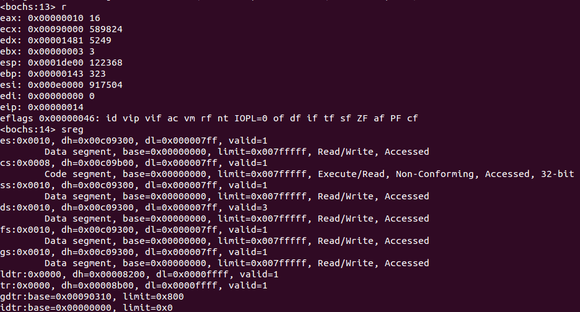
It is easy to find that
- ESP = 0x0001de00
- SS = 0x10
2.3. The Current Stack Content(user_stack)

2.4. The Stack Content Before Jumping to 'main'
The code follow is a part of boot/head.s.
...
pushl $0 # These are the parameters to main :-)
pushl $0
pushl $0
pushl $L6 # return address for main, if it decides to.
pushl $_main
jmp setup_paging
L6:
jmp L6 # main should never return here, but
# just in case, we know what happens.
...

It is easy to know that
_mainstands for address 0x0000670dL6stands for address 0x00005412
2.5. The Stack Content After 'ret' to 'main'

2.6. The Stack Content After Saving Callee-save Registers
According to the calling convension, the registers (ebp, ebx, edi, esi) should be saved in the sub-routine.
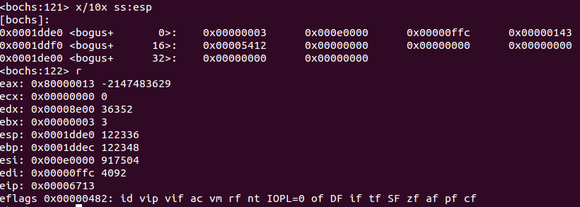
2.7. The Stack Content Before Call 'mem_init'
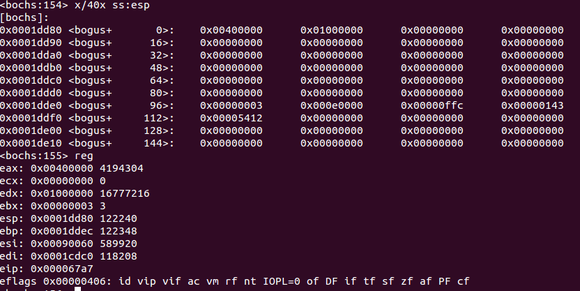
2.8. The Stack Before 'iret' in 'movetouser_mode'

2.9. The Registers After 'iret'
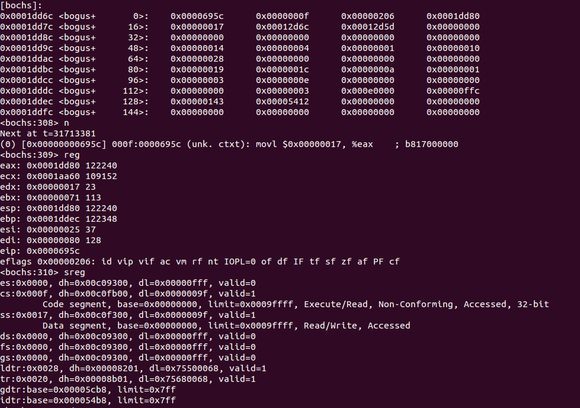
2.10. The Stack Content After 'iret'

2.11. The Registers Before 'int 0x80'

2.11. The Stack Content Before 'int 0x80'

2.12. The Registers After 'int 0x80'
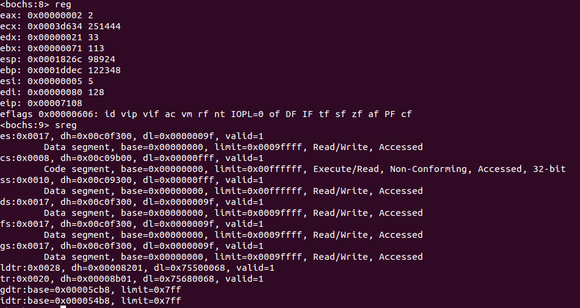
2.13. The Stack Content After 'int 0x80'

Notice: 2.12 and 2.13 shows the registers change and stack switch!!!
3. Conclusion
The
user_stackis used by kernel before Process 0move to user mode.The
user_stackis used asPrivilege 3 stack(so-calleduser stackof Porcess 0) by Process 0 after itmove to user mode.When Process 0 executes
int 0x80, the hardware will switch stack toPrivilege 0stack (so-calledkernel stackof Porcess 0) along with Privilege changing from3to0.The Process 0 and Process 1 share the
user_stackas theiruser stack.
blog comments powered by Disqus